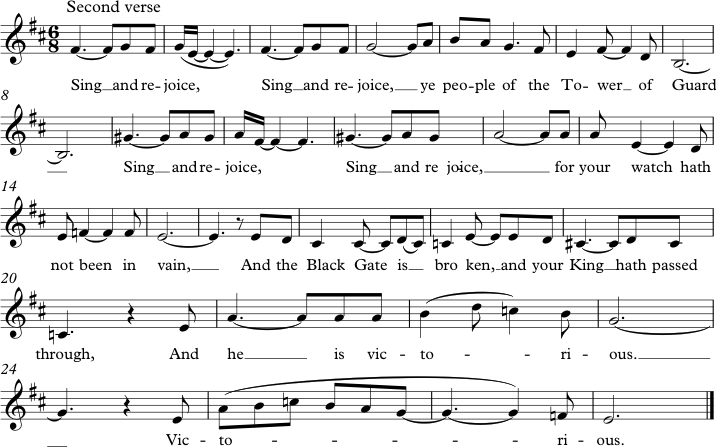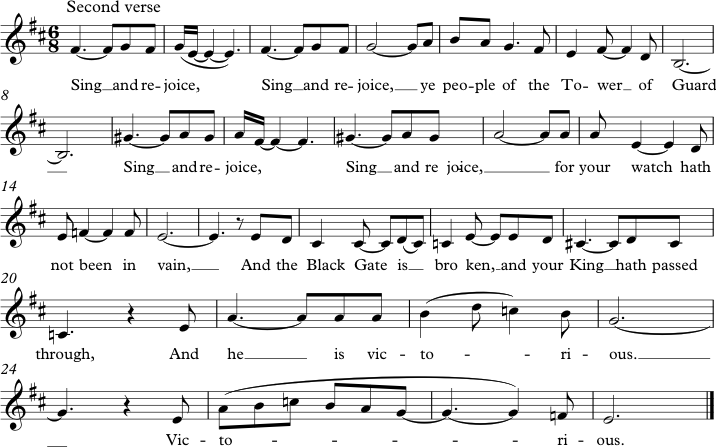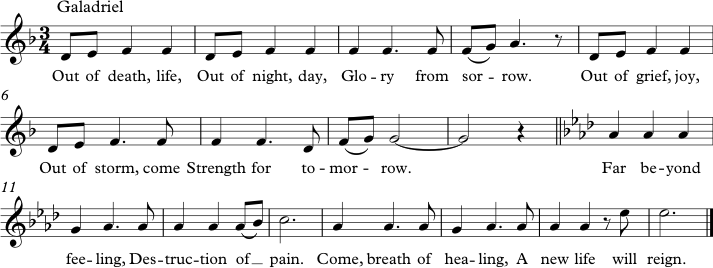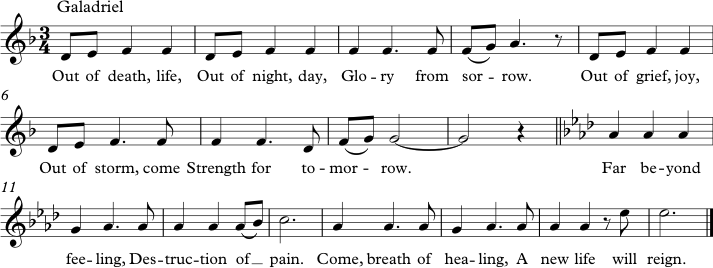Tolkien Ensemble, The Eagle’s Song (I), TE CD 4, Track 13, 3:24.
The Lord of the Rings Musical, The Final Battle, LotR M, Track 16, 3:22, from 2:06.
The Lord of the Rings Musical, The Final Battle, LotR M, Track 16, 3:22, from 2:06.
After Frodo has succeeded in his task and the ring is destroyed, the glad tidings are brought to Minas Tirith by one of the mighty Eagles, who already played a major role both in The Hobbit as well as in The Lord of the Rings, when Gandalf was rescued from atop Orthanc and later from the peak of Silvertine by Gwaihir. The song is notable in that the Eagle in The Lord of the Rings is the only occurrence of an animal clearly speaking or even singing. The text says that the Eagle “came crying”, so we cannot say whether he spoke or sang. Regardless, his song made the victory over Sauron known to the whole city.
Sing now, ye people of the Tower of Anor,
For the Realm of Sauron is ended for ever,
And the Dark Tower is thrown down.
Sing and rejoice, ye people of the Tower of Guard,
For your watch hath not been in vain,
And the Black Gate is broken,
And your King hath passed through,
And he is victorious.
For the Realm of Sauron is ended for ever,
And the Dark Tower is thrown down.
Sing and rejoice, ye people of the Tower of Guard,
For your watch hath not been in vain,
And the Black Gate is broken,
And your King hath passed through,
And he is victorious.
Sing and be glad, all ye children of the West,
For your King shall come again,
And he shall dwell among you
All the days of your life.
And the Tree that was withered shall be renewed,
And he shall plant it in the high places,
And the City shall be blessed.
Sing all ye people!
(LotR, 963).
For your King shall come again,
And he shall dwell among you
All the days of your life.
And the Tree that was withered shall be renewed,
And he shall plant it in the high places,
And the City shall be blessed.
Sing all ye people!
(LotR, 963).
The Tolkien Ensemble clearly saw this song not as a mere report of a winged messenger bringing good news from the battlefield, but as a victory hymn. The rendition shows striking parallels to the Song of Durin (see 4.1.4): Both songs use a large symphonic orchestra and are heavily modelled on late-romantic English sacred music in the style of Elgar. Most of what we have said about the Song of Durin and its intentions also holds true for the Eagle’s Song. In its style it is clearly marked as a representative song celebrating the victory over Sauron, in this case not representing a particular race, but all the races of Middle-earth – supposedly even the numerous races that aided Sauron, for they were deceived by him. After the Battle of the Hornburg the captured enemy soldiers were surprised of the generosity of the Rohirrim and maintained that their masters told them lies. In the book nothing suggests that the people sang the same song as the Eagle after he relayed his message, though it is confirmed that they did indeed sing. The version by the Ensemble suggests this, though: After the introduction with signalling trumpets, evoking the trumpets of Gondor frequently mentioned in the text, the solo bass vocalist sings the first stanza (0:07):
transcription (refrain): The Eagle’s Song, TE CD 4, Track 13.
http://soundcloud.com/middle-earth-music/4-1-10-the-eagles-song-refrain/s-Y0KSm
This is then repeated by a mixed chorus in a four-part setting, probably representing the population of Minas Tirith (if the song is meant to represent the original performance in Minas Tirith), or all the free peoples of Middle-earth (if the Ensemble intends to represent the song as a victory song commonly sung by people to celebrate the victory over Sauron). After a repetition of the introduction and a modulation to the dominant of the dominant15, the Eagle then sings the second stanza (0:44), with the phrase “sing and rejoice” repeated in the second line.
transcription (verse 1): The Eagle’s Song, TE CD 4, Track 13.
http://soundcloud.com/middle-earth-music/4-1-10-the-eagles-song-sing/s-uRNn7
The choir then repeats the first stanza as a refrain. The third stanza (1:46), describing the king coming back, again is sung by the Eagle, but with the choir repeating single phrases in the background. The last stanza follows without the refrain being sung again (2:32). Finally, both the choir and the Eagle sing the refrain one last time. The song closes with a repeated “Sing all ye people!” and ends with the exclamation “Sing!”.
The content of the lyrics speaks for the use of the song as a representative piece about the beginning of the reign of King Elessar: Not only is his coming directly referred to, but also the renewing of the White Tree. The line “And he shall plant it in the high places” refers to the King not only bringing Gondor back to glory, but also to the re-establishing of the kingdom of Arnor. This is supported by the use of a signal call played by the trumpets both as an introduction as well as an interlude between verses and chorus. Reduced to only the signal call, this is what it looks like:
transcription (signal call): The Eagle’s Song, TE CD 4, Track 13.
http://soundcloud.com/middle-earth-music/4-1-10-the-eagles-song-signal/s-zYawm
Musically, as with the Song of Durin, it is unlikely that Middle-earth music completely sounded like Elgar. We may excuse this by seeing it as an outcome of the focus of the Tolkien Ensemble: To bring across the general ideas and concepts from the songs and poems, translated into modern musical idioms. For a celebration hymn that needs to be very festive, while at the same time having an air of eternity (after all those songs are hopefully remembered for centuries, as per Sam’s wish on the way to Mount Doom), the choice of sacred music, which by its very nature conveys such a sense of tradition and perseverance, seems prudent.
The stage show has a similar moment of reflection and appreciation of the moment Sauron is vanquished: In the musical number The Final Battle, showing the destruction of the Ring in the Crack of Doom, Galadriel sings what can be described as a relieved comment to the fortunate outcome (at 2:06), when the Ring is destroyed. While most of the text is unique to the song, four lines from the song Wonder are included, which in turn is based on Galadriel’s Song of Eldamar from the book (see 4.1.11):
Out of death, life, Out of night, day
Glory from sorrow.
Out of grief, joy, Out of storm, come
Strength for tomorrow.
(LotR M, Track 15)
transcription (excerpt): The Final Battle, LotR M, Track 16.
While the lyrics are completely different from the Eagle’s Song, they nevertheless convey the same sense of relief. The “breath of healing” possibly refers to the White Tree, the re-establishing of the kingdom of Arnor or simply to the rebuilding of the free world in general after the reign of Sauron is over. The last line (“A new life will reign”) can be taken as a reference to the reign of King Elessar. Galadriel in this musical therefore takes the role of the eagle messenger in the book. We can even find musical parallels to the way in which the song is structured both in the musical and the Eagle’s Song: If we leave out the underscore in the stage show where the Ring is destroyed and begin with Galadriel’s entrance, her singing the verse solo is similar to the Eagle singing the “refrain” in the Eagle’s Song. In the Eagle’s Song, the refrain is marked as such by being repeated by the choir representing the people; in the musical the refrain is recognized because the listener has heard it before – in the song Wonder. Galadriel then sings the last two lines while the choir repeats the chorus underneath her singing. Both songs show the culmination of the efforts of the Fellowship – we might even interpret the line “destruction of pain” in the musical as an allusion to Sméagol, who is now liberated from the destructive force of the Ring and finally has peace.








